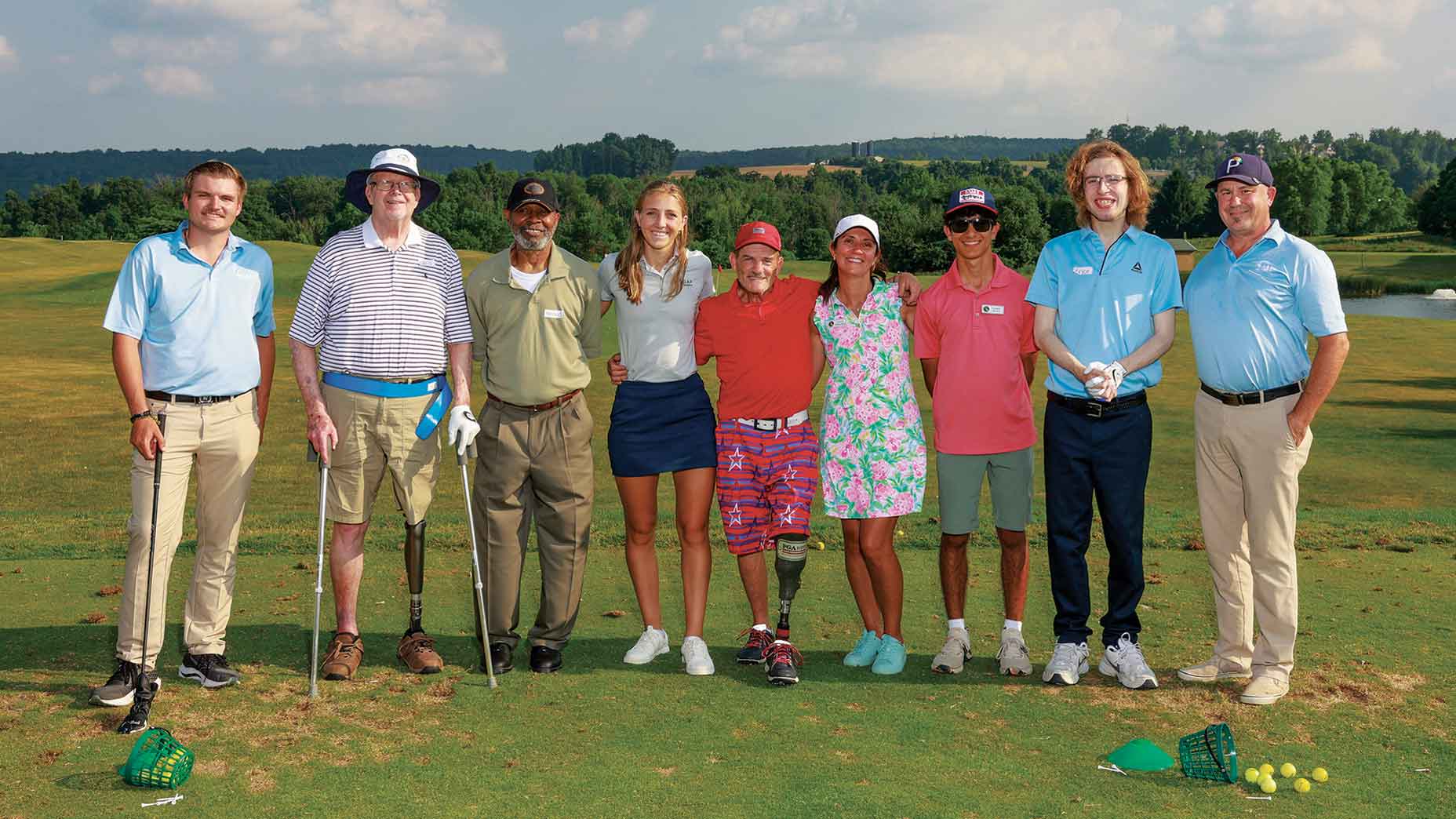SOUTHERN PINES, N.C. — There’s never a “best” time to lose a golf club, but there certainly is a worst one.
That time is approximately 9:30 on a muggy Tuesday morning in North Carolina, just as you make the turn at Mid Pines Inn and Golf Club. The sun is beating down upon you from high above, sapping the ground of the leftover moisture from last night’s thunderstorm. You (and your coworker) are covered in sweat, rethinking your every life decision. With every soggy step, your feet — which are drenched — feel more like squeegees.
You, in another spectacular display of sadism, have elected to play more than 80 holes of golf in less than 48 hours. You’re on the ninth tee box at Mid Pines — staring down a tee shot and, soon, many of the toughest short-game conditions on planet earth — and you have lost your 60-degree wedge.
For a moment, you allow yourself to feel sorry. Then you know better. Imagine Nelly Korda — who will be playing the U.S. Women’s Open across the road from where you stand — doing the same thing on Thursday of tournament week at Pine Needles. Of course you can’t! She’d never do something so doltish. No professional golfer (or even a serious amateur, for that matter) would be caught dead in such a thoughtless mistake.
Finally, you swallow your pride and call the pro shop, which quickly zips into action in search of your lost weapon. After a few minutes, a man in a golf cart appears brandishing your lost wedge — and the unmistakable look of paternal disappointment.
With tail tucked between your legs, you thank the kind man and return to your round.
Only seventy-two holes to go.
The North Carolina Sandhills are a special place. From New York, a flight into Raleigh-Durham gets you close, and that leaves about an hour in the car before the first golf courses appear.
But a few footsteps are all you need to understand why architects have been building championship-caliber courses here for the better part of the last century. The earth is soft and sandy — perfect for building golf courses — and the natural undulations are loaded with pine straw.
So when my bosses tasked my colleague Zephyr Melton and me with finding a way to highlight the region’s rich golf culture, we came to them with a simple question: Why not show all of it?
Quickly, we hatched a plan to see the best of the best — five courses, all remarkable, all worth traveling a great distance to see, and separated by only 20 miles. We intended to play Pine Needles, Pinehurst Nos. 2 and 4, The Cradle and, of course, Mike Strantz’s delightfully unhinged Tobacco Road.
But we just missed out on Pine Needles. The beloved (and revered) design from Donald Ross (and restored by Kyle Franz) could not host us on account of the U.S. Women’s Open. Soon, the best players in the world would descend upon Pine Needles with far more virtuous goals: glory, history, and the largest purse in tournament history. So instead we added Mid Pines, another Ross/Franz gem right across the street.
Then came more bad news. With a tight deadline and time constraints, we’d have to resurrect our “Bethpage Gauntlet” days and play all five courses … in two days.

Dear reader, I don’t expect you to feel pity for me. I have a dream job, one that occasionally “requires” me to travel to places to play exotic and famous golf courses for free. This is, I realize, an honor that many hard-working people pay real money to do in their free time.
But I do expect you’ll find it in your heart to feel an ounce of pity for my feet. Because whether you’re standing on the crystal-white beaches of Tahiti or the filthiest subway stop in Manhattan, a blister is a blister. And after our barefoot second round of the day at The Cradle, they were forming over the calluses on my feet.
When we made it off Gil Hanse’s brilliant, miniature creation and onto the first tee at his 7,000-yard behemoth, Pinehurst No. 4, I knew I was in for a long afternoon. On No. 4, our third round of the first day, Zephyr and I found the “friendly” slopes Hanse added to the course to be … decidedly less friendly.
We battled our way through No. 4, which is as fun and as challenging as it is so often said to be. Finishing on a hot afternoon with enough time to slink into Pinehurst Brewing Co. for dinner. We sat silently as we tore through tender pulled pork and brisket, massaging our suddenly cramping muscles as we ate.
By the time 10 p.m. rolled around, the two of us were already in bed. We’d walked 25,000 steps — some 12 miles — and burned more than 4,000 calories. And the next morning, we’d be doing it all over again.
We found a brief reprieve the next morning at Tobacco Road, which (to our secret delight) is a carts-only facility. But that was the end of our good fortune. In an effort to conserve energy, we decided not to warm up, which was, to put it lightly, a spectacular mistake.
Playing Tobacco Road preparation-free is a bit like somersaulting parachute-free out the side of a plane — it is insane, stupid, and an imminent cause of self-destruction. And almost all of that is due to the golf course, which is unlike anything else in golf.
Strantz’s design is a psychedelic journey in golf. Bunkers shoot dozens of feet in the air. Blind tee shots lead to fairways wider than a freeway. The greens, in some instances, appear literally smaller than postage stamps. It’s a course you have to see to believe, and even then, you’re not quite sure whether to trust your eyes.

Finally, we made our way to Pinehurst No. 2, the countless-time USGA Championship host and the area’s unofficial headline act.
As you’ve no doubt heard before, No. 2 is beastly — a truly demanding (and worthy) U.S. Open test. Its “turtleback” greens swat away approach shots gleefully. Its bunkers are jagged and deep. Its angles and swales make par an earnest effort, even on its most manageable holes. But on the back end of 63 holes of golf, I found myself most impressed with No. 2’s playability.
It’s almost impossible to lose a golf ball on No. 2 (trust me — I tried), and surprisingly easy to make bogey. Even the worst tee shots are only a punch shot back into the fairway, and many of the par-5s are reachable in two from the right tees.
As with many of the best courses in the world, No. 2’s difficulty makes it good, but its easiness makes it great.
Eventually, our golf marathon ended on the 18th green at Pinehurst No. 2. It was dark now, and our knees had swelled to the size of bowling balls.
Our stomachs growled and our bones ached. We’d played 81 holes of golf, walked more than 23 miles, burned more than 7,000 calories. It was time to go home. To not swing a golf club. To remain a safe distance away from the North Carolina Sandhills ’till our travels brought us back here again for the U.S. Women’s Open.
We were, of course, exhausted. But we were also astonished.
“I don’t know that we played a single bad golf hole over the last two days,” Zephyr said as we drove back to the airport.
When we’d first hatched plans to head to the Sandhills, we hoped to showcase the rich history of golf in the area. But we’d forgotten why the tapestry was so large. We’d spent two complete days doing nothing but playing golf, and we still hadn’t seen the full scope of the area. With apologies to Adam Smith, when it comes to the Sandhills, the law of diminishing returns need not apply.
Above all else, that is the lesson in our golf marathon experience. That the golf in this tiny piece of North Carolina is as good as it is anywhere in the world. That every course and every hole is memorable in its own very special way. That this region is the home of American golf — with championship tests befitting the very best men and women in the world.
And oh yeah, that next time, we’re going to need at least three days.












